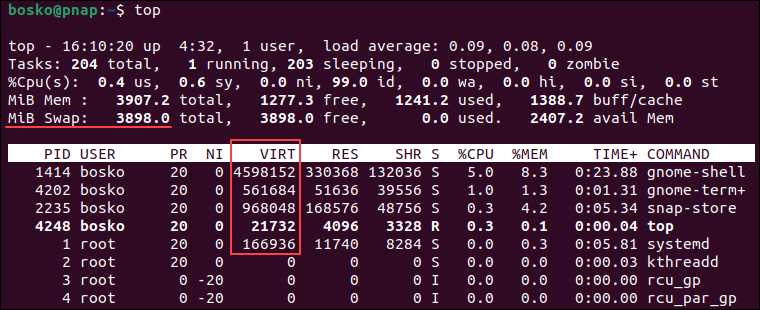
Linux is an operating system known for its flexibility and powerful features. One of the key components of Linux is its ability to manage files efficiently. In a virtual memory system, the swap partition plays a crucial role in optimizing the performance of the operating system.
Swap files in Linux are used to extend the available virtual memory by utilizing a portion of the hard disk space. This allows the system to handle more processes and applications simultaneously, preventing memory-related issues such as crashes or slowdowns. Understanding how to swap files in Linux is essential for any system administrator or Linux enthusiast.
In this comprehensive guide, we will explore the various aspects of swapping files in Linux. We will cover topics such as creating a swap partition, enabling and disabling swap files, adjusting swap file size, and monitoring swap usage. Whether you are a beginner or an experienced user, this guide will provide you with the knowledge and tools to effectively manage swap files in Linux.
Understanding the Basics of File Swapping in Linux

In a Linux operating system, file swapping is a crucial process that helps manage the system’s memory efficiently. When the available physical memory is insufficient to handle the workload, Linux utilizes a technique called swapping to transfer data between the RAM and the hard disk.
File swapping involves creating a dedicated partition on the hard disk known as a swap partition. This partition acts as a virtual memory extension for the system, allowing it to temporarily store data that cannot fit in the physical memory.
When the system runs out of available RAM, it starts moving less frequently accessed files and data to the swap partition. This frees up space in the physical memory for more critical processes and applications. The swapped files are then retrieved from the swap partition when needed.
The Linux kernel manages the file swapping process, constantly monitoring the memory usage and deciding which files to swap based on their priority and usage patterns. By intelligently swapping files, the system can ensure optimal performance and prevent crashes or slowdowns caused by memory exhaustion.
It is important to note that file swapping should not be confused with file copying or moving. Swapping refers specifically to the process of transferring data between the RAM and the swap partition, while copying or moving files involves transferring them between different storage locations.
Overall, file swapping plays a vital role in the efficient utilization of system resources in a Linux environment. By effectively managing the memory usage, Linux ensures that the system can handle a wide range of tasks and applications without running out of memory.
| Key Points |
|---|
| – File swapping in Linux involves transferring data between the RAM and a dedicated swap partition on the hard disk. |
| – The swap partition acts as a virtual memory extension for the system. |
| – The Linux kernel manages the file swapping process, prioritizing files based on their usage patterns. |
| – File swapping is essential for efficient memory management and optimal system performance. |
What is File Swapping?

In an operating system like Linux, files are stored in the file system, which is typically located on a hard drive or other storage device. However, when the system runs out of available memory, it can use a technique called swapping to temporarily move some of the less frequently used files from memory to a special partition on the hard drive called the swap partition.
Swapping allows the operating system to free up memory for other processes and applications that need it more urgently. When a file is swapped out, its contents are written to the swap partition, and the memory it occupied is freed up for other use. When the file is needed again, it can be swapped back into memory from the swap partition.
File swapping is an essential part of the memory management system in Linux and other operating systems. It helps ensure that the system can continue to run smoothly even when memory resources are limited. By intelligently swapping files in and out of memory, the operating system can optimize performance and prevent crashes or slowdowns due to insufficient memory.
Why is File Swapping Important in Linux?

In the Linux operating system, file swapping plays a crucial role in optimizing system performance and ensuring efficient memory management.
When a computer runs out of physical memory (RAM) to store data, it utilizes a technique called virtual memory to compensate for the shortage. Virtual memory uses a portion of the hard drive known as the swap partition to temporarily store inactive or less frequently accessed files. This allows the operating system to free up RAM for more critical tasks.
File swapping in Linux offers several benefits:
- Increased System Stability: By utilizing swap space, Linux can prevent system crashes and out-of-memory errors that could occur if the RAM is completely exhausted.
- Improved Performance: Swapping files to the swap partition allows the operating system to efficiently manage memory resources, ensuring that frequently used files are stored in RAM for faster access.
- Support for Memory-Intensive Applications: File swapping enables Linux to handle memory-intensive applications, such as virtual machines or large databases, that require more memory than is physically available.
- Flexibility: The size of the swap partition can be adjusted to meet the specific needs of the system, providing flexibility in managing memory resources.
Overall, file swapping is an essential feature in Linux that helps optimize system performance, improve stability, and ensure efficient memory management.
How Does File Swapping Work in Linux?
In the Linux operating system, file swapping, also known as paging or virtual memory, is a technique used to manage the system’s memory. When the system runs out of physical memory, it uses a portion of the hard disk called a swap partition to temporarily store inactive memory pages.
The swap partition acts as an extension of the system’s physical memory, allowing the operating system to allocate more memory to running processes than the physical RAM can accommodate. When a process needs more memory than is available in RAM, the operating system swaps out less frequently used memory pages from RAM to the swap partition, freeing up space in RAM for the new memory pages.
The Linux kernel manages the swapping process by using a page replacement algorithm, such as the Least Recently Used (LRU) algorithm. This algorithm determines which memory pages should be swapped out to the swap partition based on their usage patterns. Pages that have not been accessed for a long time are more likely to be swapped out, while frequently accessed pages are kept in RAM to improve performance.
When a process requires access to a swapped-out memory page, the Linux kernel swaps it back into RAM from the swap partition. This process is transparent to the process itself, as it continues to operate as if the memory page was always in RAM.
It is important to note that excessive swapping can significantly impact system performance, as accessing data from the swap partition on the hard disk is much slower than accessing data from RAM. Therefore, it is recommended to have enough physical memory to avoid excessive swapping and ensure optimal system performance.

